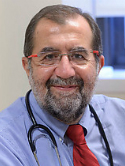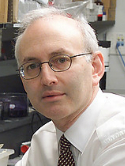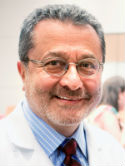Transplantation in remission improves the disease-free survival of patients with advanced myelodysplastic syndromes treated with myeloablative T cell-depleted stem cell transplants from HLA-identical siblings Journal Article
| Authors: | Castro-Malaspina, H.; Jakubowski, A. A.; Papadopoulos, E. B.; Boulad, F.; Young, J. W.; Kernan, N. A.; Perales, M. A.; Small, T. N.; Hsu, K.; Chiu, M.; Heller, G.; Collins, N. H.; Jhanwar, S. C.; Van Den Brink, M.; Nimer, S. D.; O'Reilly, R. J. |
| Article Title: | Transplantation in remission improves the disease-free survival of patients with advanced myelodysplastic syndromes treated with myeloablative T cell-depleted stem cell transplants from HLA-identical siblings |
| Abstract: | From 1985 to 2004, 49 patients with advanced myelodysplastic syndromes (MDS) (≥5% blasts) or acute myeloid leukemia (AML) transformed from MDS underwent T cell depleted bone marrow or peripheral blood hematopoietic stem cell transplantation (HSCT) from HLA-identical siblings following conditioning with a myeloablative regimen that included total body irradiation (44 patients) or busulfan (5 patients). Thirty-six patients received chemotherapy (3 low dose and 33 induction doses) before conditioning, and 13 patients did not receive any chemotherapy. Prior to transplantation, 22 of the 36 treated patients were in hematologic remission; 4 were in a second refractory cytopenia phase (26 responders); 8 had failed to achieve remission; and 2 of the responders had progression or relapse of their MDS (10 failures). No post-transplantation pharmacologic prophylaxis for graft-versus-host disease (GVHD) was given. The median age was 48 yrs (range 13-61). Forty-five of the 49 patients engrafted; 2 had primary graft failure; and 2 died before engraftment. Only 3 patients developed acute GVHD (aGVHD) (grades I and III) and 1 chronic GVHD (cGVHD). At 3 yrs post-transplantation, the overall survival (OS) was 54% in the responders; 31% in the untreated group; and 0% in the failure group (P=.0004). The disease free survival (DFS) was 50%, 15% and 0% in each group respectively (P=.0008). In multivariate analysis, disease status before cytoreduction remained highly correlated with DFS (P<.001). The cumulative incidence (CI) of relapse at 2-yrs post-transplantation for the responders was 23%; for the untreated group was 38%; and for the failures was 50%. The CI of non-relapse mortality at 2-yrs post-transplantation, for the responders was 23%; for the untreated group was 38%; and for the failures was 40%. All survivors achieved a Karnofsky Performance Status (KPS) of ≥90. These results indicate that patients with advanced MDS who achieve and remain in remission or a second refractory cytopenia phase with chemotherapy before conditioning can achieve successful long-term remissions following a myeloablative T cell depleted allogeneic HSCT. © 2008 American Society for Blood and Marrow Transplantation. |
| Keywords: | adolescent; adult; clinical article; controlled study; treatment outcome; disease-free survival; middle aged; retrospective studies; acute granulocytic leukemia; overall survival; busulfan; fludarabine; mortality; advanced cancer; disease free survival; cytarabine; rituximab; drug megadose; antineoplastic agent; t-lymphocytes; carboplatin; low drug dose; etoposide; aciclovir; cyclophosphamide; melphalan; herpes simplex; herpes zoster; stem cell transplantation; hematopoietic stem cell transplantation; continuous infusion; thiotepa; siblings; cancer regression; correlation analysis; acute graft versus host disease; chronic graft versus host disease; engraftment; graft failure; hla matching; myeloablative conditioning; myelodysplastic syndrome; whole body radiation; transplantation conditioning; long term care; remission induction; donor lymphocyte infusion; cancer relapse; methylprednisolone; multivariate analysis; seizure; sibling; t cell depletion; recombinant granulocyte colony stimulating factor; anthracycline; graft vs host disease; drug dose regimen; peripheral blood stem cell transplantation; granulocyte colony stimulating factor; cytopenia; atovaquone; fluconazole; foscarnet; ganciclovir; mycosis; voriconazole; hla antigens; lymphocyte depletion; aspergillosis; phenytoin; azacitidine; myelodysplastic syndromes; thymocyte antibody; whole-body irradiation; toxoplasmosis; transplantation, isogeneic; viremia; diaziquone; amphotericin b lipid complex |
| Journal Title: | Biology of Blood and Marrow Transplantation |
| Volume: | 14 |
| Issue: | 4 |
| ISSN: | 1083-8791 |
| Publisher: | Elsevier Inc. |
| Date Published: | 2008-04-01 |
| Start Page: | 458 |
| End Page: | 468 |
| Language: | English |
| DOI: | 10.1016/j.bbmt.2008.02.006 |
| PUBMED: | 18342789 |
| PROVIDER: | scopus |
| PMCID: | PMC4498391 |
| DOI/URL: | |
| Notes: | --- - "Cited By (since 1996): 12" - "Export Date: 17 November 2011" - "CODEN: BBMTF" - "Source: Scopus" |
Altmetric
Citation Impact
BMJ Impact Analytics
MSK Authors
-
 512
512Kernan -
 234
234Small -
 329
329Boulad -
 400
400Heller -
 618
618Van Den Brink -
 347
347Nimer -
 420
420Papadopoulos -
 459
459Jakubowski -
 945
945Perales -
 187
187Hsu -
 320
320Young -
 293
293Jhanwar -
 333
333Castro-Malaspina -
 748
748O'Reilly -
 90
90Collins -
 10
10Chiu
Related MSK Work



